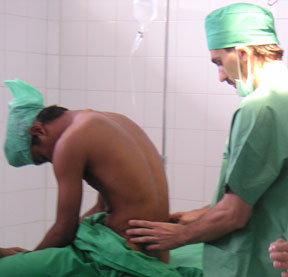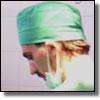Dr. Giovanni Brescia, an anaesthesiologist, is part of a Doctors Without Borders/Médecins Sans Frontières (MSF) surgical team working in Lamno town, in Aceh province on the Indonesian island of Sumatra. In the sub-district of Lamno, 25 out of 48 villages were washed away. Out of a population of around 24,000, more than 7,000 were killed and another 8,000 are now homeless. In some areas all that remain of where families once farmed are forests of snapped, charred, tree stumps. In others, mile after mile of debris have transformed vast expanses into giant garbage dumps. Amidst the debris live the displaced people.
|
– Dr. Giovanni Brescia |

|
Today started out as a quiet Sunday. There were lots of people at the market in town, and many people in the village. The clinic was quiet, just a few patients recovering. Then suddenly two cases came at the same time.
The first was a nine-year-old boy who had had a motorbike accident and suffered head wounds. The other was a 14-month baby who had swallowed half a cup of kerosene.
We very quickly decided to refer them both to the hospital in Banda Aceh, two and a half hours away. Although I am an anesthetist and we have rehabilitated the clinic here to include surgery facilities, we can't perform neurosurgery and I was worried that if the boy's condition worsened we wouldn't be able to treat him. The baby was in a poor condition too.
I left at lunchtime with the patients and family in the ambulance. It was newly donated to the village and this was the first time we'd used it. I wondered what these people did before aid organizations arrived. There were no surgical facilities at all and the cost of referral to Banda Aceh would have been too great for most families. Was their only alternative to just wait and hope for the best? I think so.
At the moment, a lot of our surgery is a result of injuries from heavy machinery. There is so much reconstruction going on after the tsunami and people are not always familiar with the equipment. Yesterday, we had a man whose chest was cut open by a propeller blade and a young boy who had chopped off his toes.
I was not here for the tsunami, but it is everywhere around you. Everyone was affected. The man with the chest wound is living in barracks and lost his wife and children. The young girl tending him was made an orphan. The boy who lost his toes has also lost his brothers and sisters. Out of 16,900 people living in Lamno, 7,100 were killed and 8,000 are now homeless. It's hard to imagine.
And the trauma is ongoing. We are still seeing patients with psychosomatic symptoms or in a state of panic. They speak of various physical complaints such as stomach pains or headaches but the cause is mental rather than physical. These people are struggling to cope. Almost all of the people I have met are terrified of another tsunami and it doesn't help that we get three or four earthquakes here a week. It's no wonder people are having difficulties adjusting.
Fortunately we have a psychologist working inside the clinic so we can refer patients directly to them for individual counseling. We also have mental health teams visiting camps, villages, and schools. We receive many patients like this.




